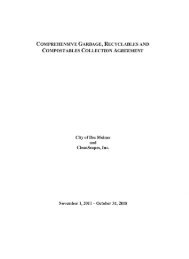CITY OF DES MOINES SHORELINE MASTER PROGRAM
CITY OF DES MOINES SHORELINE MASTER PROGRAM
CITY OF DES MOINES SHORELINE MASTER PROGRAM
You also want an ePaper? Increase the reach of your titles
YUMPU automatically turns print PDFs into web optimized ePapers that Google loves.
Des Moines Shoreline Inventory and Characterization<br />
material. Such obstructions include human-built structures such as bulkheads, breakwaters,<br />
groins, docks, and boat ramps. In areas where the beach is depleted, erosion accelerates.<br />
Owners of property adjacent to the shore commonly construct rock or concrete bulkheads to<br />
protect the bank or bluff from erosion. Such measures can increase beach depletion as wave<br />
energy is reflected rather than absorbed. The shoreline processes and conditions along Des<br />
Moines are summarized in the Net-shore Drift of King County (Chrzastowski, 1982) which<br />
updated the coastal drift section of the Coastal Zone Atlas of King County (Ecology, 1979) and<br />
are currently being reevaluated by Johannessen and others (personal communications) in work<br />
underway for WRIA 9 and WRIA 8. Specific conditions in Des Moines are discussed in the<br />
section of this report titled Nearshore Physical Characterization.<br />
Historic Land Use Development<br />
The Des Moines area was traditionally used by Native Americans for salmon fishing and<br />
clamming in the streams and shoreline before European settlement. Europeans began to arrive in<br />
the early 19th century, first as explorers and later as settlers. The first homestead claim<br />
certificate in the Des Moines area was granted to John Moore in 1872. In 1889 the plat of the<br />
Town of Des Moines was recorded (Des Moines Historical Society, 2004).<br />
Land use in the area has always focused on the shoreline. By the early 20th century the Puget<br />
Sound had become a busy waterway as Seattle and Tacoma grew as port cities. The Sound<br />
provided transportation for recreation, food, and natural resources. During World War I, Des<br />
Moines became a destination for summer visitors, many of whom built large homes. Also at this<br />
time an existing dock was enlarged to accommodate a ferry that made runs between Vashon<br />
Island and Des Moines. Food and recreation continued to be the main attractions in the 1920’s<br />
and 1930’s. Des Moines Beach Park and Salt Water Park were developed during this time (Des<br />
Moines Historical Society, 2004).<br />
During and after World War II the population of Des Moines boomed. The City was officially<br />
incorporated in 1959. Commercial development in the upland areas was further spurred first<br />
when Highway 99 (Pacific Highway South) was built in the 1920’s, and then when Interstate-5<br />
and its associated interchanges were built in the 1960’s. Development in recreation continued as<br />
well. In the 1970’s the City built the Marina and fishing pier.<br />
Development along the Des Moines shoreline has historically been dominated by single-family<br />
housing. Today the City is highly developed, predominantly by single-family homes, with multifamily,<br />
and commercial areas located in the Downtown/Marina area, along Pacific Highway, I-5,<br />
and arterial streets such as the Kent-Des Moines Highway (City of Des Moines, 2002). Figures<br />
6a and 6b show the current city limits and surrounding area in 1942 and 2002 respectively. The<br />
air photos illustrate two important points in characterizing the Puget Sound shoreline in Des<br />
Moines. First, development at the water’s edge has been in place for decades (see the downtown<br />
Des Moines, Zenith, Woodmont, and Redondo areas in 1942). Second, upland development<br />
throughout the Des Moines area watershed has removed vegetation and increased impervious<br />
surface area. These conditions are characteristic of western King County and the Puget Sound<br />
shoreline. The City’s development and urbanization have resulted in increased stormwater<br />
runoff and peak flows with associated flooding and increased pollutant loads in streams. These<br />
conditions affect fish and wildlife habitat and natural stream morphology. The City is expected<br />
Page 12 March 2005



